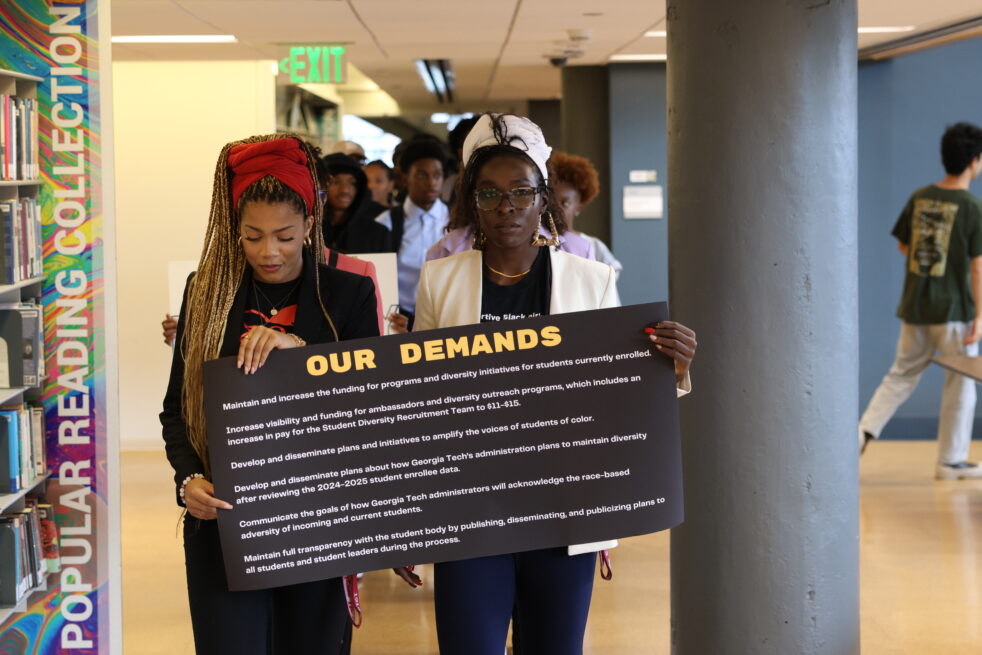On Oct. 20, the Institute’s chapter of the National Association for the Advancement of Colored People (NAACP) led the Under-Represented Groups in Education (U.R.G.E.) in a demonstration on Tech’s campus.
The NAACP is a national organization that works towards creative legislation towards diversity, equity, inclusion and equality everywhere. They organize nonviolent demonstrations centered on making sure legislation and bills are passed that are in line with the needs of all African Americans and other underrepresented minorities. The demonstration was geared towards not just Tech, but all of the University System of Georgia (USG) institutions.
The Technique had the opportunity to interview Camille Trotman, a third-year LMC and the president of the NAACP. She and many other members of the Black and Latinx student organizations on campus were setting up for the rally that started at 1:30 p.m. and continued till 3:30 p.m.
Trotman explained the main objective of the demonstration was to create visibility for the students affected by the overturning of affirmative action, mainly, Black and Latinx students.
“We want to show them that we as students want to see them continue to prioritize the need to foster diversity on campuses and make sure it’s an environment that’s safe and accessible to all students,” said Trotman.
On June 29, the U.S. Supreme Court voted in a 6-3 decision to end affirmative action at the higher education level. This ruling overturned a 40-year precedent that allowed colleges to consider race in the admissions practice.
From the 1960s onwards, admissions departments began to consider race in the admission process. This involved increasing access to education for underrepresented groups and making an effort to desegregate colleges by considering the white and persons of color applicants equally. These efforts led institutions around the world to see a higher percentage of minority applicants as the accessibility and consideration for their higher education increased.
In 1980, over 80% of students in college were white, and by 2020, the number had dropped by 26%, as universities continued to execute affirmative action policies.
The decision to end affirmative action arose from two cases: Students for Fair Admissions (SFFA) v. Harvard and SFFA v. The University of North Carolina at Chapel Hill (UNC).
The court majority determined that the ability to ascertain an individual’s identity should be based purely on their academic merit — challenges bested and lessons learned — instead of the color of their skin. The support for the ruling is split halfway; there are just as many supporters as there are defenders.
Trotman emphasized that the demonstration did not aim to focus too much on the recent repeal of affirmative action. She confirmed that trying to reverse the legislation wasn’t realistic or beneficial.
“How schools [can] be proactive,” Trotman said, “[is] to see that, to make sure that everything that affirmative action brought to the plate can still be maintained so we don’t see dramatic decreases in what is already such a small amount of black students on campuses like Georgia Tech because we really can’t afford that.”
Many Black and Latinx student organizations were at the protest. Trotman mentioned that they were all worried that the overturning may lead to minorities being even less represented at the institute.
“With there already being such a small amount of Black and Hispanic students, there is a lingering fear that the communities will become smaller and even less visible than they already are. … When you walk into a classroom and don’t see people who look like you, it diminishes your sense of belonging and you feel estranged. This is to prevent that from happening even more,” Trotman said.
The demonstration began at Burger Bowl and then continued onto the rest of campus. Twospecific locations were chosen as important stops – the John Lewis Student Center and the Clough Undergraduate Learning Commons – because of the high student presence that they had.
After that, the protest moved to Tech Tower, where many administrative employees’ offices are located on campus.
“This move was calculated and was a visual thing. It was to show the administration that we’re here, and we are in front of your offices, and our presence will be felt. It felt like we took a step back,” Trotman said.
Trotman talked about several actions she believed could be taken to make this ruling easier on underrepresented communities. She mentioned that the Institute already has solid diversity plans drafted and proposed, and the goal was to tell the administration that they were ready to help roll some of the plans out.
In fact, the demonstration has a second phase. They will be submitting a bill to the NAACP headquarters that plans to support Black students and minorities at primarily white institutions (PWIs) so that there is legislation built towards fostering diversity, equity and inclusion following the demonstration.
One example she provided was ensuring potential Tech recruits were informed about Black student spaces or organizations that would make them feel like they belonged, which would further incentivize Black students
to apply to the university.
Trotman further mentioned that if any students wanted to learn more about the demonstration, there were more activities to look forward to from the NAACP, such as a forum held by student organizations where the conversation about affirmative action would continue. Students can follow @gt_naacp on Instagram for more updates.
She concluded by saying, “We want transparency, security, and funding, and we want to see that the University System of Georgia is proactive instead of reactive.”
